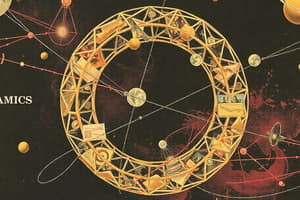Podcast
Questions and Answers
What is the main principle behind the arrangement of electrons in an atom?
What is the main principle behind the arrangement of electrons in an atom?
- Electrons occupy fixed orbits like planets around the sun.
- Electrons always move randomly around the nucleus.
- Electrons fill energy levels and sublevels based on energy levels. (correct)
- Electrons are arranged based on their charge only.
Which of the following represents an example of an electron configuration?
Which of the following represents an example of an electron configuration?
- ¹⁰Ne = 1s² 2s² 2p⁶ (correct)
- ¹⁰Ne = 1s² 2s² 2p⁴
- ¹⁰Ne = 2s² 2p⁶ 3s²
- ¹⁰Ne = 3s² 3p²
According to the Aufbau principle, how do electrons fill the orbitals?
According to the Aufbau principle, how do electrons fill the orbitals?
- Electrons fill the highest energy orbitals first.
- Electrons can fill any available orbital without a specific order.
- Electrons fill orbitals based on their mass.
- Electrons fill orbitals starting from the lowest energy levels. (correct)
What does Hund's rule state about electron distribution in orbitals?
What does Hund's rule state about electron distribution in orbitals?
How many electrons can each orbital accommodate?
How many electrons can each orbital accommodate?
What term did Democritus use to describe the smallest piece of matter?
What term did Democritus use to describe the smallest piece of matter?
According to John Dalton's theory, what is true about atoms of the same element?
According to John Dalton's theory, what is true about atoms of the same element?
What did J.J. Thomson discover in 1897?
What did J.J. Thomson discover in 1897?
Which model of the atom is associated with J.J. Thomson?
Which model of the atom is associated with J.J. Thomson?
What was Ernest Rutherford's key contribution to atomic theory?
What was Ernest Rutherford's key contribution to atomic theory?
In the Bohr model, electrons are said to move in a manner analogous to which of the following?
In the Bohr model, electrons are said to move in a manner analogous to which of the following?
What improvement did Arnold Sommerfeld make to the Bohr model?
What improvement did Arnold Sommerfeld make to the Bohr model?
What is the significance of Erwin Schrödinger in atomic theory?
What is the significance of Erwin Schrödinger in atomic theory?
Flashcards
Atom
Atom
The smallest particle of an element; the smallest amount of a substance that can take part in a chemical reaction.
Democritus' Atom
Democritus' Atom
Democritus's idea of the atom, proposing indivisible and different-shaped particles.
Dalton's Atomic Theory
Dalton's Atomic Theory
All elements are composed of atoms; atoms of the same element are identical; compounds form from atoms combining.
Thomson's Model
Thomson's Model
Signup and view all the flashcards
Rutherford's Experiment
Rutherford's Experiment
Signup and view all the flashcards
Bohr Model
Bohr Model
Signup and view all the flashcards
Sommerfeld's Modification
Sommerfeld's Modification
Signup and view all the flashcards
Electron
Electron
Signup and view all the flashcards
Electron Configuration
Electron Configuration
Signup and view all the flashcards
Electron Orbital
Electron Orbital
Signup and view all the flashcards
Aufbau Principle
Aufbau Principle
Signup and view all the flashcards
Pauli Exclusion Principle
Pauli Exclusion Principle
Signup and view all the flashcards
Hund's Rule
Hund's Rule
Signup and view all the flashcards
Study Notes
Atomic Theory History
- Atoms are the smallest particles of an element.
- Atoms are the smallest amount of a substance that participates in chemical reactions.
- Democritus, a Greek philosopher, searched for a description of matter.
- He named the smallest piece of matter "atomos" (indivisible).
- These atoms were small, hard particles, all made of the same material, but different shapes and sizes.
- John Dalton (English chemist) performed experiments leading to the acceptance of the atomic theory.
- He deduced that all elements are composed of atoms.
- Atoms of the same element are exactly alike.
- Atoms of different elements are different.
- Compounds are formed when atoms of different elements combine.
- J.J. Thomson (English scientist) discovered the electron and suggested the "Plum Pudding" model.
- Atoms have structure—a positively charged substance, with negatively charged electrons embedded in it, like plums in a pudding.
- Ernest Rutherford (English physicist) conducted experiments to understand the atom's structure.
- He found that atoms contain a small, dense, positively charged nucleus.
- Negatively charged electrons orbit around this nucleus.
- Niels Bohr (Danish scientist) refined Rutherford's model.
- Electrons orbit the nucleus in specific energy levels.
- Arnold Sommerfeld refined Bohr's model to include elliptical orbits for electrons.
- Erwin Schrödinger (physicist and biologist) considered the Father of Quantum Mechanics; today's atomic model is based on the principles of wave mechanics.
- Electrons do not move in fixed paths like planets around the sun; instead, space in which electrons are likely to be found is termed electron cloud.
- The arrangement of electrons in energy levels around the atom's nucleus is called electron configuration. The energy levels are further divided into sublevels (s, p, d, and f). Each sublevel contains specific number of orbitals.
Studying That Suits You
Use AI to generate personalized quizzes and flashcards to suit your learning preferences.




